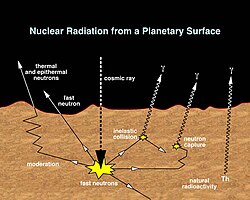This article needs additional citations for verification .(April 2015) |


The Gamma Ray Spectrometer (GRS) is a gamma-ray spectrometer on the 2001 Mars Odyssey spacecraft, a space probe orbiting the planet Mars since 2001. Part of NASA's Mars Surveyor 2001 program, it returns geological data about Mars's surface such as identifying elements and the location of water. It is maintained by the Lunar and Planetary Laboratory at the University of Arizona in the United States. This instrument has mapped the distribution surface hydrogen, thought to trace water in the surface layer of Martian soil. [1]